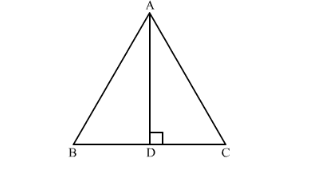In an equilateral triangle ABC if AD ⊥ BC, then
(a) $5 \mathrm{AB}^{2}=4 \mathrm{AD}^{2}$
(b) $3 \mathrm{AB}^{2}=4 \mathrm{AD}^{2}$
(c) $4 \mathrm{AB}^{2}=3 \mathrm{AD}^{2}$
(d) $2 \mathrm{AB}^{2}=3 \mathrm{AD}^{2}$
$\triangle \mathrm{ABC}$ is an equilateral triangle and $\mathrm{AD} \perp \mathrm{BC}$.

In ∆ABD, applying Pythagoras theorem, we get
$\mathrm{AB}^{2}=\mathrm{AD}^{2}+\mathrm{BD}^{2}$
$\mathrm{AB}^{2}=\mathrm{AD}^{2}+\left(\frac{1}{2} \mathrm{BC}\right)^{2}\left(\because \mathrm{BD}=\frac{1}{2} \mathrm{BC}\right)$
$\mathrm{AB}^{2}=\mathrm{AD}^{2}+\left(\frac{1}{2} \mathrm{AB}\right)^{2}(\because \mathrm{AB}=\mathrm{BC})$
$\mathrm{AB}^{2}=\mathrm{AD}^{2}+\frac{1}{4} \mathrm{AB}^{2}$
$3 \mathrm{AB}^{2}=4 \mathrm{AD}^{2}$
We got the result as $(b)$.
Click here to get exam-ready with eSaral
For making your preparation journey smoother of JEE, NEET and Class 8 to 10, grab our app now.
